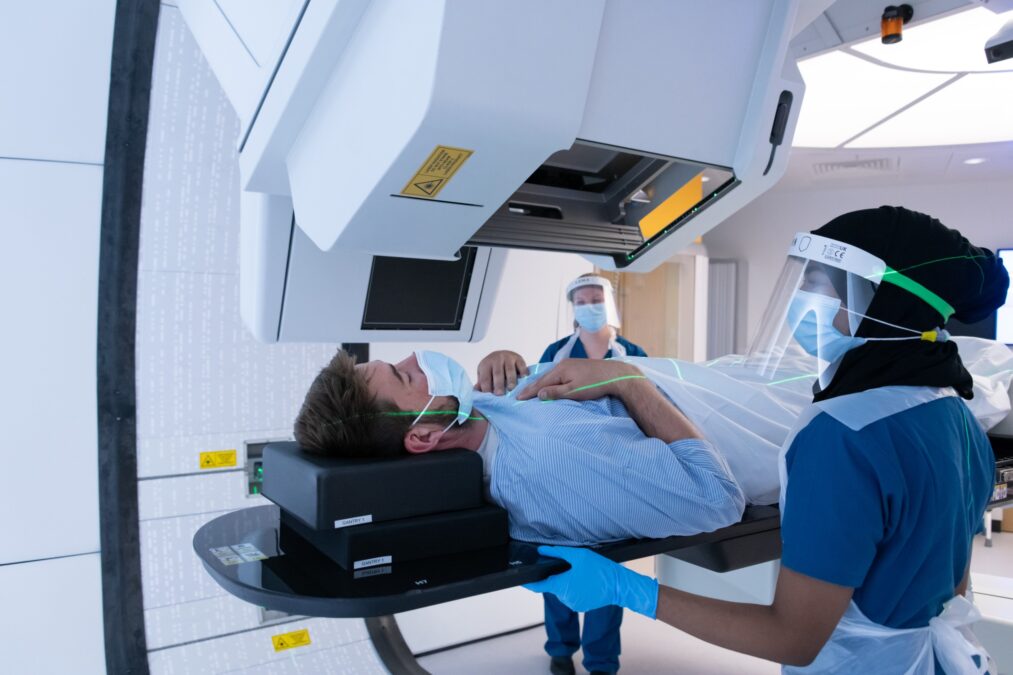Each year, approximately 4,800 people are diagnosed with soft tissue and bone sarcomas in the UK. Sarcomas are a rare type of cancer that develop from cells of the body’s soft, connective tissues, such as bones, muscles, tendons, cartilage, and fat. Sarcomas can develop anywhere in the body and can affect individuals of all ages. Sarcomas can be aggressive, and early detection and treatment are crucial.
Treatment options for sarcomas will vary depending on the type, stage and location of the cancer. It may include one or a combination of surgery, radiation therapy including proton beam therapy, chemotherapy and targeted therapy.
Sarcomas are typically classified as either:
- Soft tissue sarcomas, which develop in the body’s soft tissues
- Bone sarcomas, which develop in the bone.
Sarcomas is a rare cancer, and the exact cause is often unknown. However, research suggests that a certain range of factors may increase the risk of developing sarcoma, including age, previous radiotherapy treatment, genetic disorders and chemical exposure.
What treatment options are there for soft tissue sarcomas?
Treatment options for soft tissue sarcomas will vary depending on the characteristics of the cancer, including the type, stage, and location, and also the general health of the patient.
Following a diagnosis of sarcoma, a treatment plan will be developed with the patient and a specialist healthcare team. The plan to treat sarcomas may include one or a combination of surgery, radiotherapy including proton beam therapy, chemotherapy and targeted therapies.
Here we look in more detail at the different types of treatment options available:
Surgery
Surgery for soft tissue sarcoma is a very specialised treatment and is an important part of treatment to cure the tumour. The aim of surgery is to completely remove all of the tumour, along with some normal tissue around it (called the surgical margin). It can sometimes be referred to as wide local excision surgery.
If the sarcoma is found at an early stage and has not spread from where it started, surgical treatment can be very effective.
Surgery for soft tissue and bone sarcomas is carried out by a specialist surgeon experienced in treating sarcoma patients.
Not all sarcomas can be removed through surgery.
Radiotherapy
Radiotherapy plays an important role in the treatment of sarcomas. For high-grade sarcoma, sarcoma larger than 5cm and a sarcoma that can’t be completely removed with surgery, radiotherapy is the standard treatment in the UK.
It treats soft tissue sarcoma by using high-energy radiation beams to destroy cancer cells. Radiotherapy may be given before or after surgery, or as definitive treatment if surgery is not being used. It can also treat secondary cancer that has spread in the body, or to shrink or slow the growth of advanced sarcoma.
Radiotherapy is typically administered daily in small doses (called fractions) over a period of days or weeks.
Proton Beam Therapy
Proton beam therapy is a type of radiotherapy that is considered a good treatment option for certain types of sarcomas for several reasons:
- Precise targeting: Proton beams can be precisely aimed and controlled to deliver radiation to cancer cells of a tumour while sparing surrounding healthy tissue, which is important if sarcomas are close to critical structures.
- Reduced side effects: By sparing healthy tissue, proton beam therapy can potentially reduce the risk of side effects and improve outcomes for patients.
- High dose delivery: Proton beams can deliver a high dose of radiation directly to the tumour.
- Favourable outcomes: Early studies suggest that PBT can result in high rates of tumour control and fewer side effects for certain types of sarcoma cancers.
Proton beam therapy targets and destroys cancer cells using high-energy protons as opposed to X-rays (photons) or other high-energy radiation sources.

Sometimes called particle therapy, it is very precise in how it delivers a dose to the tumour, and it is this enhanced precision compared with photon therapy that provides the particular benefits.
Chemotherapy
Depending on the type and stage of sarcoma, chemotherapy may be given as the main treatment or as an adjuvant (addition) to another treatment, such as before or after surgery. It can be beneficial to try to shrink soft tissue sarcoma, control its growth or relieve any symptoms.
Chemotherapy works well for soft tissue sarcoma, and some types of bone cancer, particularly Ewing sarcoma and osteosarcoma.
Chemotherapy uses anti-cancer (cytotoxic) drugs to destroy and kill cancer cells. It is administered either intravenously, via a drip, or in tablet form. Once administered, the drug will circulate throughout the body in the bloodstream and works by attacking rapidly dividing cells in the body.
To learn more about the advances in sarcoma treatments, please read our blog.
What is the first-line treatment for soft tissue sarcoma?
Surgery with or without radiotherapy is usually the preferred treatment for soft tissue sarcoma.
How are soft tissue sarcomas treated depending on the stage?
Treatment for soft tissue sarcomas will be dependent on a range of factors, including the stage and characteristics of the tumour and also the general health of the patient. Knowing the stage helps doctors decide on the best treatment for the patient.
The stages of soft tissue sarcomas range from stages I (1) through IV (4); the lower the number, the less the cancer has spread.
Macmillan Cancer Research shared the following information regarding how a number stage is used for the diagnosis of soft tissue sarcomas:
- Stage 1A – The cancer is smaller than 5cm, and either it is low grade or the grade is not known.
- Stage 1B – The cancer is bigger than 5cm, and either it is low grade or the grade is not known.
- Stage 2 – The cancer is smaller than 5cm, and it is either moderate or high grade.
- Stage 1 and 2 – soft tissue sarcomas have not spread to lymph nodes or other parts of the body.
- Stage 3A – The cancer is bigger than 5cm but not bigger than 10cm. It is either moderate or high grade, and it has not started to spread.
- Stage 3B – Can be either of the following:
- The cancer is bigger than 10cm. It is either moderate or high grade, and it has not started to spread.
- Or the cancer is of any size and grade and has spread to at least one lymph node. It has not spread to any other parts of the body.
- Stage 4 – The cancer is of any size and grade. It may or may not have spread to lymph nodes. But it has spread to other parts of the body such as the bones, liver or lungs. This is often referred to as secondary or metastatic cancer.
Knowing the stage helps doctors decide on the best treatment for the patient.
Book a consultation with our private sarcoma specialists
At Proton International London Private Sarcoma Service, we specialise in treating bone and soft tissue sarcomas using proton beam therapy (PBT).
Our highly respected sarcoma oncologists work in conjunction with our first-class clinical colleagues at UCLH NHS Foundation Trust and UCLH Private Healthcare.
They have a strong interest in clinical research and provide a comprehensive and high-quality service to patients with a variety of cancers. They have extensive experience in treating sarcomas and offer proton beam therapy as a unique treatment option in the UK.
Conclusion
Treatment options for sarcomas will vary depending on the type, stage, and location of the tumour, as well as the overall health and preferences of the patient. A patient diagnosed with sarcoma will be looked after by a multidisciplinary group of healthcare professionals who specialises in sarcoma treatment.
Working with the patient, specialist healthcare professionals will determine the most appropriate treatment plan for each individual case. Treatment options include surgery, radiotherapy, including proton beam therapy, chemotherapy, and targeted therapies. A patient may undergo just one form of treatment or multiple treatment types.
As well as offering proton beam therapy treatment to sarcoma patients at Proton International London, our world-leading cancer clinicians work as part of a larger team treating and caring for bone and soft tissue sarcoma patients of all ages at UCLH.
FAQs about sarcoma treatments
To learn more about Sarcoma treatments, take a look at our frequently asked questions below or contact us today:
What is the survival rate of soft tissue and bone sarcomas?
The earlier a patient is diagnosed with soft tissue sarcoma the more successful treatment can be. According to Cancer Research UK, almost 45 out of 100 people (almost 45%) survive their soft tissue sarcoma at 10 years or more after diagnosis, and 55 out of 100 people (55%) survive their bone sarcoma at 10 years or more after diagnosis.
How common are soft tissue sarcomas?
Soft tissue sarcomas are a group of rare cancers that can occur in people of all ages, although more common in adults. There are approximately 4,300 cases diagnosed in the UK each year. They develop in the soft tissues that connect, support and surround other body structures and organs. Soft tissue sarcomas can be found in fat, muscle, blood vessels, deep skin tissues, tendons and ligaments.
Due to their rarity, soft tissue sarcomas require specialised medical expertise in diagnosis, treatment, and management. A patient who is diagnosed with soft tissue sarcomas will be treated with a multidisciplinary approach involving oncologists, surgeons, radiation oncologists, and pathologists who have experience and expertise in treating soft tissue sarcoma.
How fast do soft tissue sarcomas grow?
The growth rate of soft tissue sarcomas can vary widely depending on various factors, including the specific type of sarcoma, its location and its grade. Some soft tissue sarcomas may grow relatively slowly over a period of months to years, while others may grow more rapidly over weeks to months.
The growth rate of a soft tissue sarcoma can change over time and may be influenced by various factors, such as the aggressiveness of the tumour, the immune response of the body, and the effectiveness of any treatments that are being administered.
If left untreated, the cancer cells will continue to divide, and the sarcoma will grow in size. This reinforces the importance of early diagnosis to improve treatment outcomes.
What do soft tissue sarcomas look like?
Soft tissue sarcomas can have different appearances, as they can arise from various types of tissues within the body. They can present as a lump or mass, which may be firm, soft, or rubbery to the touch. The lump may be located under the skin or deeper within the body, and it may or may not be painful.
Soft tissue sarcomas can also cause other visible changes on the skin, such as discolouration, swelling, or changes in texture. In some cases, soft tissue sarcomas may not be visible externally and may only be detected through diagnostic imaging tests, such as MRI, CT scan, or ultrasound.
It’s important to note that the appearance of a soft tissue mass does not necessarily indicate whether it is benign or malignant, and detailed and thorough medical evaluation, including biopsy, is needed for accurate diagnosis.
What are the risk factors for soft tissue sarcoma?
Soft tissue sarcoma diagnoses are rare and the cause of them is often unknown. Research has identified that there are certain risk factors which may increase the likelihood of developing soft tissue sarcoma, these are:
- Radiation exposure, including previous radiotherapy treatment
- Genetics (having mutations in genes that predispose to developing sarcomas)
- Age
- Environmental exposure to certain toxins
It’s important to note that having one or more of these risk factors does not necessarily mean that an individual will develop soft tissue sarcoma, and most people with soft tissue sarcomas do not have any identifiable risk factors.
How do doctors detect soft tissue sarcoma?
A sarcoma diagnosis typically involves a combination of medical history evaluation, physical examination, imaging studies, blood tests and a biopsy, each of which is carried out by highly experienced doctors and healthcare professionals.
Once a soft tissue sarcoma is diagnosed, further testing may be done to determine the stage of cancer (whether cancer has spread in the body), which helps in determining the most appropriate treatment plan. Staging may involve additional imaging studies, such as chest X-rays, CT scans, or MRI scans, as well as other tests depending on the location and characteristics of the tumour.

This article has been clinically reviewed by Proton International Medical Director and Consultant Clinical Oncologist, Dr Beatrice Seddon. Dr Seddon specialises in the use of radiotherapy (including proton beam therapy) and chemotherapy for the management of soft tissue and bone sarcomas.





